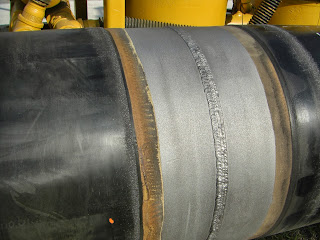Heat shrink technology has been around for decades. In that time, there have been many, many different applications and uses for it. This has ranged from factory electrical uses (read more here) to telecommunications, to heat tracing to the corrosion prevention of pipelines. Pipeline corrosion prevention is what we will be discussing here.
Pipelines are generally built in 40 foot segments (you've probably seen a pipe truck loaded with 40 foot joints of pipe driving down the freeway before). Those pipe joints are coated in a plant; with the most commonly used pipe coating in the United States being FBE. When these pipe joints are coated in the plant, a small space is left uncoated at the end of each pipe joint. This is called the 'cutback'. The cutbacks are there because as the pipe joints are ultimately welded together; any coating right at the ends of that pipe would be damaged during the welding process anyway.
So once the pipeline is welded together; what is left (in terms of coating) is essentially: 39.5 feet of factory applied FBE; then 6" of bare steel; then 39.5 feet of factory applied FBE; then 6" of bare steel; then 39.5 feet of factory applied FBE; then 6" of bare steel; etc.
This is (of course) a pretty large problem. Bare steel can corrode very quickly when buried, subsea or even above ground. A coating has to be put on that field joint (or girth weld). That is where heat shrinkable sleeves come into the picture as one very commonly and successfully used solution. As you would expect, we have a variety of options in terms of material types; all designed for different pipeline conditions, temperatures and applications (for a list of the different shrink sleeve coating options we have, see here).
 |
| Example of a bare field joint on a Three Layer PE (TLPE) coated pipeline. |
So once the pipeline is welded together; what is left (in terms of coating) is essentially: 39.5 feet of factory applied FBE; then 6" of bare steel; then 39.5 feet of factory applied FBE; then 6" of bare steel; then 39.5 feet of factory applied FBE; then 6" of bare steel; etc.
This is (of course) a pretty large problem. Bare steel can corrode very quickly when buried, subsea or even above ground. A coating has to be put on that field joint (or girth weld). That is where heat shrinkable sleeves come into the picture as one very commonly and successfully used solution. As you would expect, we have a variety of options in terms of material types; all designed for different pipeline conditions, temperatures and applications (for a list of the different shrink sleeve coating options we have, see here).
No comments:
Post a Comment